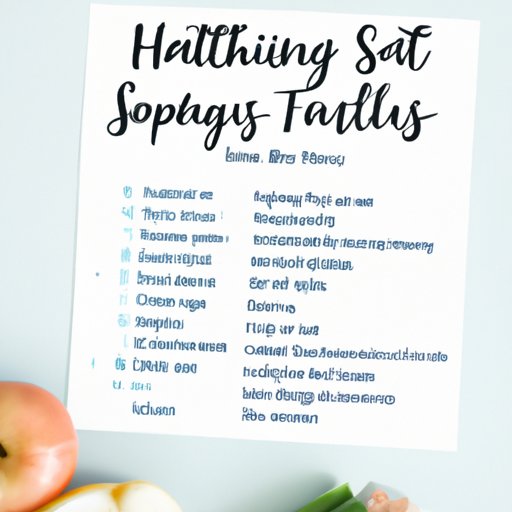Introduction
Eating healthy is an important part of maintaining overall health and wellbeing. Unfortunately, it can be difficult to know where to start when it comes to making changes in our diet. This article will provide information on how to make healthy food choices, including recipes for easy-to-prepare meals, tips for grocery shopping and meal prepping, and the importance of portion control.
Recipes for Healthy Meals That Are Easy to Make
Making healthy meals doesn’t have to be complicated. There are plenty of recipes available online that are quick and easy to prepare. Here are some examples of healthy dishes that you can make:
- Stir-fry with vegetables and lean protein
- Salads with beans, nuts, and grilled chicken
- Veggie omelets with avocado and tomatoes
- Whole wheat pasta dishes with shrimp or tofu
- Smoothies with fresh fruit and Greek yogurt
When preparing healthy meals, there are a few tips that can help save time. First, try to use ingredients that are already pre-cut or pre-washed. For example, buying pre-cut vegetables or canned beans can help speed up the cooking process. Second, cook in batches and freeze leftovers for later. This way, you can make several meals at once and have them ready to go for busy days.
Benefits of Eating a Balanced Diet
Eating a balanced diet is important for getting the right amount of nutrition. Each type of food provides different vitamins and minerals that are necessary for optimal health. Fruits and vegetables are rich in antioxidants and fiber, while lean proteins such as fish, poultry, and beans provide essential amino acids. Whole grains contain complex carbohydrates and are a good source of energy. Dairy products, such as milk and yogurt, are a great source of calcium and vitamin D.
In addition to providing essential nutrients, a balanced diet also offers other health benefits. Eating a variety of foods helps support a healthy immune system and reduce the risk of certain diseases. Eating enough fruits and vegetables can also lower blood pressure and reduce the risk of heart disease. Finally, a balanced diet can help maintain a healthy weight, which is important for overall health and wellbeing.

Choosing Nutritious Ingredients at the Grocery Store
When shopping for groceries, it’s important to look for nutritious ingredients that will help create healthy meals. Start by reading labels and looking for foods that are low in sugar, sodium, and saturated fat. Look for whole grain options and opt for lean proteins like chicken and fish instead of red meat. Avoid processed and packaged foods as much as possible, as they often contain added sugars and unhealthy fats. Try to choose organic produce when possible, as this will help reduce exposure to pesticides.
In addition to reading labels, it’s also important to pay attention to portion sizes. Many people eat more than they need, so it’s important to be mindful of how much food is being consumed. To help manage portion sizes, use smaller plates or measure out servings ahead of time.
Meal Prepping and Planning
Meal prepping and planning can be a great way to save time and ensure that healthy meals are being eaten. Before heading to the grocery store, plan out meals for the week and create a shopping list. This will help minimize impulse purchases and ensure that all necessary ingredients are purchased. Once at the store, stick to the list and avoid buying unhealthy snacks.
To save even more time, consider preparing meals ahead of time. Make large batches of food and freeze individual portions for future meals. This way, meals can be quickly reheated when needed.

The Importance of Portion Control
Portion control is an important part of eating healthy. Understanding serving sizes can help ensure that meals are balanced and contain the right amount of calories. The average adult should aim to eat about 2,000 calories a day, depending on their activity level and body size. A single serving of a food item is usually equal to one cup, or the size of a fist. Eating larger portions can lead to overeating and weight gain, so it’s important to be mindful of how much is being consumed.

Substituting Unhealthy Ingredients with Healthier Alternatives
Swapping out unhealthy ingredients with healthier alternatives is another great way to make meals more nutritious. Instead of using white bread, opt for whole wheat or rye. Use olive oil instead of butter, and replace sugary snacks with fruits or nuts. When baking, try using applesauce or mashed banana instead of sugar. These small changes can add up and make a big difference in the nutritional value of a meal.
When substituting ingredients, it’s important to keep in mind that not all swaps are created equal. Some may still be high in calories and fat, so it’s important to do research before replacing ingredients. Additionally, some swaps may affect the taste and texture of a dish, so it’s important to experiment and find the best option for each recipe.
Creating a Balanced Plate
Creating a balanced plate is an easy way to ensure that meals are nutritious and satisfying. A balanced plate should include a combination of macronutrients and micronutrients. Macronutrients include proteins, carbohydrates, and fats, and should make up the majority of the plate. Micronutrients, such as vitamins and minerals, should also be included. Aim to fill half of the plate with fruits and vegetables, and the other half with proteins and whole grains.
When creating a balanced plate, it’s important to consider the different flavors and textures of the foods. For example, adding a crunchy element, such as nuts or seeds, can add flavor and texture to a meal. Additionally, try to mix up the colors of the foods, as this can make a dish look more appealing. Finally, don’t forget to add a source of healthy fats, such as olive oil or avocado.
Conclusion
Making healthy food choices is an important part of maintaining overall health and wellbeing. By following the tips outlined in this article, it is possible to make delicious and nutritious meals that are easy to prepare. Remember to shop for nutritious ingredients, plan ahead, and pay attention to portion sizes. With a little bit of effort, it is possible to create delicious, balanced meals that are good for both the body and the soul.
(Note: Is this article not meeting your expectations? Do you have knowledge or insights to share? Unlock new opportunities and expand your reach by joining our authors team. Click Registration to join us and share your expertise with our readers.)
